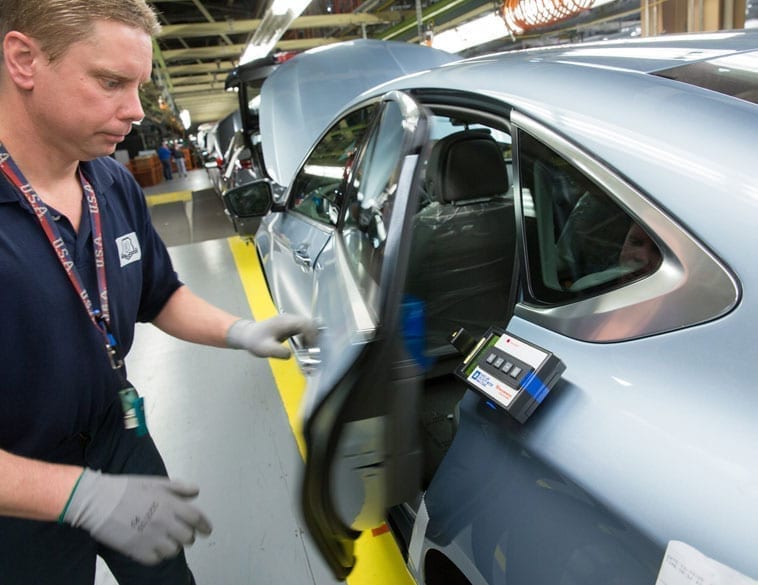We know that what happens in the U.S. often impacts economic conditions in Canada. For automotive retailers this can be particularly important given how integrated the industry is between both countries…
In Canada, many dealers are paying close attention to the evolving COVID-19 situation at home, yet what happens South of the Border in the U.S. will also likely have major ramifications given the close integration between both nation’s economies.
In the automotive sector, decisions made by U.S. based and headquartered OEMs, along with parts suppliers and other key industry stakeholders, as well as consumer sentiment, tend to directly affect the Canadian market, so it was with great interest that we signed up for the Equifax Webinar – Market Pulse: Potential Impact on the Automotive Industry in the Wake of Uncertainty.
Moderated by Byron McDuffee, Senior Vice President and General Manager, Automotive Services, Equifax and featuring Dr. Amy Crews Cutts, President and Chief Economist, Cutts & Associates, along with Jonathan Smoke, Chief Economist, Cox Automotive, the webinar delved into a whole range of topics, ranging from updates on the U.S. economic situation, to consumer sentiment and credit trends and what the result is likely to mean for automotive dealers and financial lenders.
Overall economic conditions
Crews Cutts kicked off the session by delving into some of the broader issues currently facing the U.S. economy. Through the middle of May, U.S. banks had seen deposits swell to $1.9 trillion, far greater than has ever seen before.
Additionally, she noted that credit card balances had dropped significantly with an $83 billion increase in pay offs as consumers looked to reduce debt as much as possible, since they are still not spending anywhere near as much as they normally would.
Retail sales in the U.S. have also taken a huge hit. From February through April, sales dropped by approximately $123 billion as stores were shuttered and many people had to take reduced hours or were laid off from work.
Crews Cutts noted that the 37 million unemployment figure in the U.S., although high, doesn’t really paint a true picture of the situation, as there are likely many more people that have not received their unemployment claims, since such a massive swell in those filing for benefits has overwhelmed some very old systems in certain U.S. states.
Additionally, there has been discussion that the benefits being received by many laid off workers in the U.S. are actually more than what they’d normally earn when working.
Crews Cutts citing a University of Chicago working paper that delved into the subject. “In some cases,” she said, ”through the CARES act, workers are getting double what they would normally earn.”
She argued that such a scenario can create a dis-incentive to get back to work, though the whole point was to provide temporary relief and what happens when these programs expire has yet to be seen.
Additionally, CARES act payments, like CERB in Canada are also taxable, so what happens when that money is clawed back will likely prove very interesting.
Hundreds of pandemics
Jonathan Smoke then delved into consumer sentiment across the U.S. and the impact it is having on automotive retail.
He noted that it was important to understand that COVID-19 wasn’t so much a national pandemic, but hundreds of pandemics at a local level, playing out in different ways, resulting in large variations in terms of the number of cases and infection rates, as well as consumer behaviour and economic impact between different states, counties and municipalities.
Smoke utilized a series of heat maps to show how consumer sentiment has evolved since February as well as vehicle sales at local and regional levels.
He noted that by leveraging data from its Dealertrack platform, Cox Automotive was able to provide real-time and granular statistics on how the situation continues to evolve in different markets across the U.S.
Smoke said that while data showed new vehicle sales rapidly declining through the end of March, they have since started to creep upward again in most markets, with a notable acceleration through the beginning of May as states began opening their doors for business again.
Big declines
On the retail used vehicle side, similar trends were observed, with a massive decline at the end of March/beginning of April, followed by an uptick, in fits and starts through May.
Smoke noted that because incentives for both consumers and dealers usually expire based on specific dates and times of the month, the competition from new vehicle demand tends to eat into used retail vehicle sales at those times.
He noted that in terms of the U.S. Memorial Day long weekend at the end of May—a time that is traditionally a high point for vehicle sales, there seemed to be a pause in sales growth due to the holiday, but since then demand has started to increase again, both on the new and used retail vehicle side.
In terms of wholesale in the used vehicle market, the impact of COVID-19 has been arguably even greater than retail. In March, wholesale activity declined dramatically, with some auction firms, such as Manheim, reporting a reduction in sales by as much as 80 percent. Additionally, downward pressure on wholesale prices through April also hurt the sector.
Since then however, prices have stabilized have started to trend upward again.
When we conducted our mid-month reporting for May, we had actually seen an increase of 5.7 percent in wholesale prices.
— Jonathan Smoke, Chief Economist, Cox Automotive
“If those values hold,” he added, “we will basically see that about half of the losses that were created in value in the month of April would be cut in two.”
He noted that the data Cox Automotive has been tracking since March has revealed a lot about the nature of demand and the impact caused by the pandemic, particularly since wholesale values took a major tumble when North America started bearing the full brunt of COVID-19.
Retail price trends
Smoke said that while values have started to recover, what’s interesting is the trend in retail prices. “During the early weeks of the pandemic, retail prices didn’t come down,” said Smoke, “which corresponds with anecdotal evidence that buyers in those darkest days were the ones that absolutely needed to get a vehicle, so we didn’t see any discounting in the used vehicle retail market.”
Since that time however, discounting has started to increase with Smoke reporting a 2.4 decline in retail prices at their peak in April, though he also noted that the gap between retail prices and wholesale values, that was sizeable two months ago has started to close.
“These trends directly relate to what we’ve seen on the supply side,” he said. In April, both retail and wholesale supply on the used vehicle supply stood at 115 and 149 days respectively. Since then supply has drastically reduced, with retail down to 36 days and wholesale by 41 days by the Memorial Day weekend.
Moving onto loans, Smoke said that prime and super prime rates have remained relatively stable, though declines in this segment have largely been due to the introduction of consumer enticements designed to encourage them to buy during economic uncertainty.
This not only included zero percent APR, but also payment deferral options, some with quite generous terms. Since then, some of these terms have been reduced, for as Smoke acknowledged, as current inventories tighten, and supply becomes an issue on the new vehicle side, due to OEMs having temporarily shut down production, generous incentives are likely to decline significantly over the next few months.
Sub-prime impact
In the sub-prime loan space, COVID-19 economics have had a greater impact, due to the perceived higher risk associated with these loans. So, while credit overall continues to flow, sub-prime has seen a significant tightening in terms of lending criteria with approval rates dropping since March.
Smoke also noted that in terms of market share in the auto lending space, captive finance companies (those affiliated with OEMs and traditionally associated with higher-score credit profiles) have gained a very significant market share, representing 59 percent of auto loans in the U.S., with other lenders such as banks, showing declines since the crisis began.
A question on the minds of many has been what will happen to delinquency rates and repossessions. Currently, payments through the CARES Act and emergency funds to support businesses have meant that most borrowers are doing fairly well in servicing the debt they presently owe, while delinquency rates have actually declined over the last few months.
Rockier times ahead?
Over the longer term however, things could get rockier. Crews Cutts noted that in terms of delinquency patterns, the lowest rates tend to be witnessed in the spring, with the peak coming around December and the holiday season, so it will be interesting to see what happens when the CARES Act benefits expire, as well as the loan forbearance programs currently being offered.
She also mentioned that data points to the majority of forbearance being attributed to those people with lower credit scores—in the 660 to 770 range—whereas many of the prime and super prime customers tend to be much lower risk, with a far greater tendency to pay cash for vehicles rather than financing them.
Crews Cutts also said that in terms of the market, captive finance companies are the ones that not only represent a very significant chunk of the auto lending market but the ones most apt at working with their customers on forbearance accommodation and while other lenders such as credit unions are also facilitating similar programs, they’re not doing it to the same extent as captive finance institutions.
The question of whether we’ll see a massive influx of off-lease used vehicles into the market over the next few months is also something that is weighing heavily on the minds of many in the auto retail sector. Fueling the fire, has been the highly publicized bankruptcy of Hertz Rent-A-Car.
Jonathan Smoke said at present, while we’ve seen a big boost in vehicle supply over the last few months (that has been currently trending downward), we’re likely to see further surges in used vehicle inventory, especially as fleets such as rental companies go through another round of liquidating their vehicles.
He said that looking at Hertz specifically, while the entire fleet is around 500,000 units in the U.S., at least 25 percent of that consists of program cars owned by the OEMs that will simply be returned to them once de-fleeted.
He noted that typically, the industry sees approximately 200,000 vehicles come off lease in a given month, but if a whole host of fleets plan on liquidating vehicles during a similar time frame then it could put further downward pressure on used vehicle prices, especially when combined with other projected off-lease returns over the summer and into the fall.
Repossessions
There’s also the question of repossessions, for those consumers that are 60 days delinquent or more on their loans. At present, lenders have been extremely reluctant to move forward with repossessions because it could crater the market and leave a whole of host of vehicles sitting, with no potential buyers.
Amy Crews Cutts said that under the CARES act, a change in fair credit reporting means that if an auto loan was 60 days overdue going into the current accommodation, it will continue to be reported as 60 days overdue, with the status only changed if the borrower pays off the arrears amount. The aim is to ensure that the delinquency is not masked.
Crews Cutts also feels that auto lenders will likely continue working with their clients to help them find ways to pay—in a similar fashion to the way mortgage lenders are currently doing with their clients and thereby avoid defaults. If that is the case, then we’re unlikely to see a huge ballooning of defaults, which should help ease pressure a little on the used vehicle market as well as keeping buyers (and potential) buyers financially afloat.
Looking back at history, the Great Recession of 2008-09, witnessed a significant downturn in new vehicle sales, but by 2012, things had bottomed out and new vehicle demand rallied through 2017, resulting in unprecedented sales numbers in some cases, both in the U.S. and also in Canada.
As a result, many dealers have been wondering when we might see new vehicle sales rebound. Jonathan Smoke said that that currently, it was important to regularly track what is happening in the market—at least on a monthly basis for the foreseeable future.
He noted that there are predictions of a 28-percent year-over-year decline in 2020 due to COVID-19, with most of that decline coming from fleet sales, which have been steadily increasing as an overall share of the new vehicle market in the last several years.
“When will we go back to 2017 levels? That’s tough to predict,” said Smoke. “It isn’t so much a function of demand as it is of supply and we think supply is going to be a challenge for the remainder of this year and limited into 2021 as well, even if the economy fully recovers from COVID-19.” In other words, don’t expect 2017 type sales levels for some time to come.



